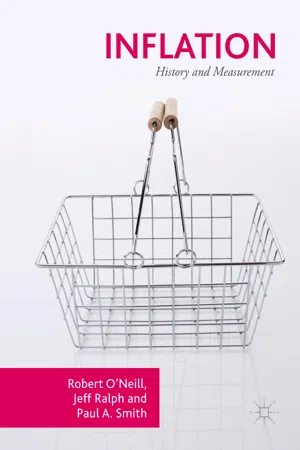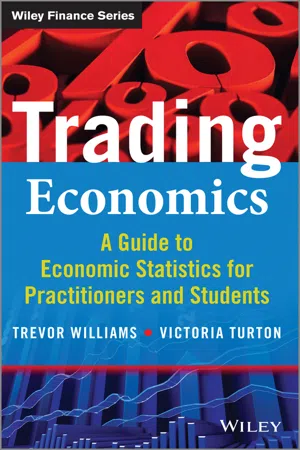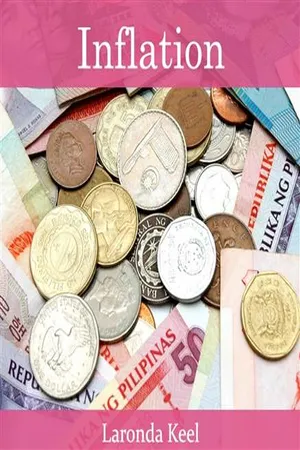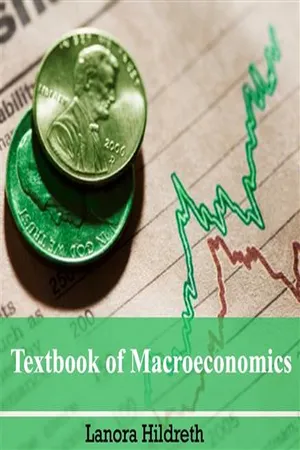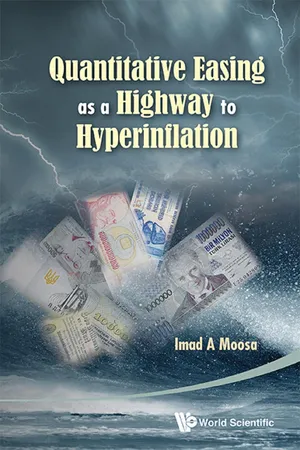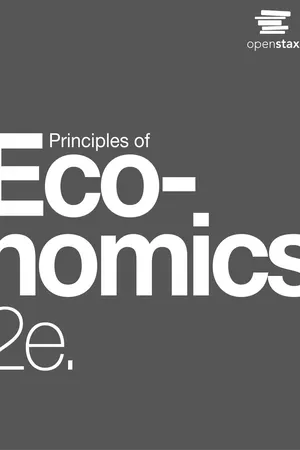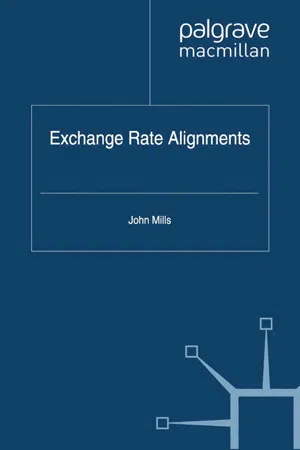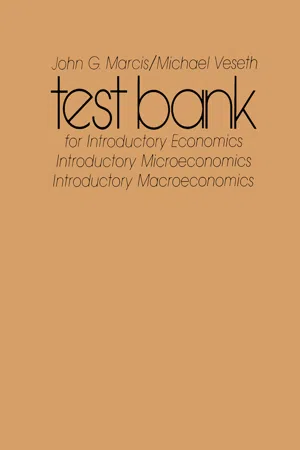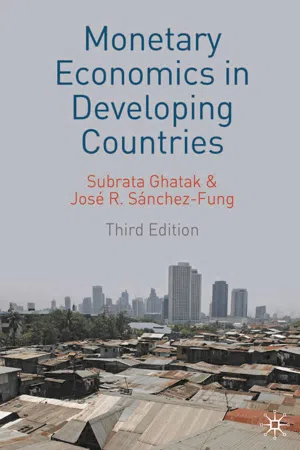Economics
Inflation and Deflation
Inflation refers to the general increase in prices of goods and services over time, leading to a decrease in the purchasing power of money. Deflation, on the other hand, is the general decrease in prices of goods and services, often resulting in reduced consumer spending and economic activity. Both inflation and deflation have significant impacts on an economy's stability and growth.
Written by Perlego with AI-assistance
Related key terms
1 of 5
11 Key excerpts on "Inflation and Deflation"
- eBook - PDF
Inflation
History and Measurement
- Robert O'Neill, Jeff Ralph, Paul A. Smith(Authors)
- 2017(Publication Date)
- Palgrave Macmillan(Publisher)
Alongside the definition of inflation, we will also often hear econo- mists make use of the term deflation which the OED defines as a reduc- tion in the level of prices in an economy. 3 This refers to periods of time in which the level of prices, however measured, is declining, rather than increasing as is the more common situation in modern economies. This definition of deflation can cause some confusion for students of Index Numbers as deflation can also be used to refer to the practice of divid- ing a series of values measured in nominal 4 money at different periods of time by one plus the percentage change in a price index measured as a decimal so that the effect of changes in the price level between the peri- ods is removed and the amounts are measured at a constant price level. Where there is any ambiguity in the course of this book, we will attempt to clarify our meaning in the context of the situation being discussed. Economists will often also make reference to a period of disinflation which represents a period in which inflation is falling from a previous level to a new lower level (for an example of this being used in context see 3 Surprisingly, the definition seems incomplete compared the earlier statement referring to infla- tion. However, deflation might also be defined as an increase in the purchasing power of money. 4 By this we mean the amounts measured in money in the time period they occur, so for example, company accounts are stated in nominal amounts, and the value of the pounds values are meas- ured in changes across the years due to inflation. 24 R. O’Neill et al. Roger 2009). For example, in the past three decades, the UK has expe- rienced a period of disinflation as inflation has fallen to a relatively very small, but generally positive, level. - eBook - PDF
Trading Economics
A Guide to Economic Statistics for Practitioners and Students
- Trevor Williams, Victoria Turton(Authors)
- 2014(Publication Date)
- Wiley(Publisher)
4 Inflation Inflation is always and everywhere a monetary phenomenon in the sense that it is and can be produced only by a more rapid increase in the quantity of money than in output. Milton Friedman 1 WHAT IS INFLATION? Inflation tells us the changing (increasing) price of a range of goods or services; basically how much of something we can get for our money. The rate of change of prices – the speed at which the price of goods and services that are bought by households or businesses alter – is called inflation. But prices can also fall, in a process called deflation, sometimes termed negative inflation. Inflation is more common than deflation, or at least it has been in the last 50 years or so, and so it has become associated with changes in the price of goods and services. Historically, however, price falls were as common as price rises, as we will see later. Both Inflation and Deflation have advantages and disadvantages, which we will explore in more detail later in this chapter. THE HISTORY OF INFLATION Inflation has been around for a long time, but, as Figure 4.1 shows, the level of prices (the index) really only rose consistently and sharply in the UK from the 1970s onwards. This was after the US came off the gold standards and the Bretton Woods system of fixed exchange rates, which had prevailed after the Second World War, ended. Money was now backed by government fiat and trust rather than by gold. And exchange rates were no longer fixed but allowed to float freely. This seems to have led to a rapid rise in the level of prices or, in other words, to the Retail Prices Index. Before that, for hundreds of years, the level 1 Friedman, M., The Counter-Revolution in Monetary Theory (1970). 100 Trading Economics Retail Price Index (1987 = 100) 0 10 20 30 40 50 60 70 80 90 100 1264 1296 1328 1360 1392 1424 1456 1488 1520 1552 1584 1616 1648 1680 1712 1744 1776 1808 1840 1872 1904 1936 1968 2000 Figure 4.1 Price index over time. - No longer available |Learn more
- (Author)
- 2014(Publication Date)
- Orange Apple(Publisher)
____________________ WORLD TECHNOLOGIES ____________________ Chapter- 1 Inflation In economics, inflation is a rise in the general level of prices of goods and services in an economy over a period of time. When the general price level rises, each unit of currency buys fewer goods and services. Consequently, inflation also reflects an erosion in the purchasing power of money – a loss of real value in the internal medium of exchange and unit of account in the economy. A chief measure of price inflation is the inflation rate, the annualized percentage change in a general price index (normally the Consumer Price Index) over time. Inflation's effects on an economy are various and can be simultaneously positive and negative. Negative effects of inflation include a decrease in the real value of money and other monetary items over time, uncertainty over future inflation may discourage investment and savings, and high inflation may lead to shortages of goods if consumers begin hoarding out of concern that prices will increase in the future. Positive effects include ensuring central banks can adjust nominal interest rates (intended to mitigate recessions), and encouraging investment in non-monetary capital projects. Economists generally agree that high rates of inflation and hyperinflation are caused by an excessive growth of the money supply. Views on which factors determine low to moderate rates of inflation are more varied. Low or moderate inflation may be attributed to fluctuations in real demand for goods and services, or changes in available supplies such as during scarcities, as well as to growth in the money supply. However, the consensus view is that a long sustained period of inflation is caused by money supply growing faster than the rate of economic growth. Today, most mainstream economists favor a low steady rate of inflation. - No longer available |Learn more
- (Author)
- 2014(Publication Date)
- White Word Publications(Publisher)
____________________ WORLD TECHNOLOGIES ____________________ Chapter-7 Inflation In economics, inflation is a rise in the general level of prices of goods and services in an economy over a period of time. When the general price level rises, each unit of currency buys fewer goods and services. Consequently, inflation also reflects an erosion in the purchasing power of money – a loss of real value in the internal medium of exchange and unit of account in the economy. A chief measure of price inflation is the inflation rate, the annualized percentage change in a general price index (normally the Consumer Price Index) over time. Inflation's effects on an economy are various and can be simultaneously positive and negative. Negative effects of inflation include a decrease in the real value of money and other monetary items over time, uncertainty over future inflation may discourage investment and savings, and high inflation may lead to shortages of goods if consumers begin hoarding out of concern that prices will increase in the future. Positive effects include ensuring central banks can adjust nominal interest rates (intended to mitigate recessions), and encouraging investment in non-monetary capital projects. Economists generally agree that high rates of inflation and hyperinflation are caused by an excessive growth of the money supply. Views on which factors determine low to moderate rates of inflation are more varied. Low or moderate inflation may be attributed to fluctuations in real demand for goods and services, or changes in available supplies such as during scarcities, as well as to growth in the money supply. However, the consensus view is that a long sustained period of inflation is caused by money supply growing faster than the rate of economic growth. Today, most mainstream economists favor a low, steady rate of inflation. - Imad A Moosa(Author)
- 2013(Publication Date)
- WSPC(Publisher)
Chapter 1INFLATION, DEFLATION, DISINFLATION AND ALL THAT1.1.What is Inflation?It is often said that inflation is inevitable, like death and taxes. This is probably because, as Sir Frederick Keith-Ross mentions, “inflation is like sin; every government denounces it and every government practices it” (Makochekanwa, 2007). Historical stories about inflationary episodes proves that it is a phenomenon that has existed ever since money was used as a medium of exchange. Inflation is a topic that receives significant attention in the media, with regular features, reports and interviews. It is an issue that is often debated by politicians in Parliament and election campaigns, let alone economists and business executives.The reason why inflation is treated with “respect” is that it affects everybody in various ways. It is an important consideration during mortgage payments and in determining the cost of essential goods and services required for survival and those that make our lives more pleasant. We anticipate news about whether the central bank will decide to cut or raise interest rates, with inflation typically being the prime consideration (at least for some central banks). Most of us are fascinated by documentaries on the great inflation in Germany during the 1920s and how it relates to the rise of Adolf Hitler. Inflation has broad implications for the state of the economy and whether or not we can keep our jobs or find new ones. While it is regarded as one of the four macroeconomic variables closely monitored by policymakers (the others being growth, employment and the balance of payments), it is often the prime indicator that triggers drastic policy actions. “Inflation targeting” is a more common concept than “output targeting”, “employment targeting” or “balance of payments targeting”.Inflation is defined in different ways, but, in general, the phenomenon is about rising prices of goods and services (hence, the cost of living). As the prices of goods and services rise, the value (or purchasing power) of money falls in the sense that a monetary unit (say a dollar) buys less and less goods and services resulting in a diminishing basket. This is why inflation is viewed as a “persistent” erosion of the value of the money. While it cost 60 pounds to purchase a first class ticket on the Titanic in 1912, there is no way these days that this amount can buy a ticket to cross the Atlantic (let alone the Pacific) in a first class cabin on an ocean liner (perhaps 10,000 pounds can do the job). It is for this reason that we give our children more pocket money than what our parents gave us. People are typically nostalgic to the “good old days” when things were very cheap — the culprit being inflation.- eBook - PDF
- Steven A. Greenlaw, David Shapiro, Daniel MacDonald(Authors)
- 2022(Publication Date)
- Openstax(Publisher)
First, the impact of inflation will differ considerably according to whether it is creeping up slowly at 0% to 2% per year, galloping along at 10% to 20% per year, or racing to the point of hyperinflation at, say, 40% per month. Hyperinflation can rip an economy and a society apart. An annual inflation rate of 2%, 3%, or 4%, however, is a long way from a national crisis. Low inflation is also better than deflation which occurs with severe recessions. Second, economists sometimes argue that moderate inflation may help the economy by making wages in labor markets more flexible. The discussion in Unemployment pointed out that wages tend to be sticky in their downward movements and that unemployment can result. A little inflation could nibble away at real wages, and thus help real wages to decline if necessary. In this way, even if a moderate or high rate of inflation may act as sand in the gears of the economy, perhaps a low rate of inflation serves as oil for the gears of the labor market. This argument is controversial. A full analysis would have to account for all the effects of inflation. It does, however, offer another reason to believe that, all things considered, very low rates of inflation may not be especially harmful. 22.5 Indexing and Its Limitations LEARNING OBJECTIVES By the end of this section, you will be able to: • Explain the relationship between indexing and inflation • Identify three ways the government can control inflation through macroeconomic policy When a price, wage, or interest rate is adjusted automatically with inflation, economists use the term indexed. An indexed payment increases according to the index number that measures inflation. Those in private markets and government programs observe a wide range of indexing arrangements. - eBook - PDF
- Steven A. Greenlaw, Timothy Taylor, David Shapiro(Authors)
- 2017(Publication Date)
- Openstax(Publisher)
First, 546 Chapter 22 | Inflation This OpenStax book is available for free at http://cnx.org/content/col12122/1.4 the impact of inflation will differ considerably according to whether it is creeping up slowly at 0% to 2% per year, galloping along at 10% to 20% per year, or racing to the point of hyperinflation at, say, 40% per month. Hyperinflation can rip an economy and a society apart. An annual inflation rate of 2%, 3%, or 4%, however, is a long way from a national crisis. Low inflation is also better than deflation which occurs with severe recessions. Second, economists sometimes argue that moderate inflation may help the economy by making wages in labor markets more flexible. The discussion in Unemployment pointed out that wages tend to be sticky in their downward movements and that unemployment can result. A little inflation could nibble away at real wages, and thus help real wages to decline if necessary. In this way, even if a moderate or high rate of inflation may act as sand in the gears of the economy, perhaps a low rate of inflation serves as oil for the gears of the labor market. This argument is controversial. A full analysis would have to account for all the effects of inflation. It does, however, offer another reason to believe that, all things considered, very low rates of inflation may not be especially harmful. 22.5 | Indexing and Its Limitations By the end of this section, you will be able to: • Explain the relationship between indexing and inflation • Identify three ways the government can control inflation through macroeconomic policy When a price, wage, or interest rate is adjusted automatically with inflation, economists use the term indexed. An indexed payment increases according to the index number that measures inflation. Those in private markets and government programs observe a wide range of indexing arrangements. - eBook - PDF
- J. Mills(Author)
- 2012(Publication Date)
- Palgrave Macmillan(Publisher)
3 The widely exhibited determination in the Western world to keep inflation down to very low levels is not, therefore, a sign of economic wisdom. It is much more convincingly seen as another sign of the 3 Inflation Inflation 41 dominance in the West of the culture and outlook of banking and finance over manufacturing and industry. Low inflation – and the high real interest rates which go with it – favours old money vis-à-vis new; lenders as against borrowers; established wealth holders as opposed to parvenus; and the already successful vis-à-vis their challengers. All these powerful groups, typically with deeply conservative instincts, have a vested interest in treating inflation as a major affliction. In fact, in moderation – at 4 to 5 per cent, to allow something of a safety margin against shocks which might push it up to more dangerous levels – it is nothing of the kind. On the contrary, it is an almost entirely unavoid- able but relatively harmless concomitant to any policies seriously orien- tated towards accelerating the growth rate and getting everyone back to work. A particularly strong link in the chain of inflationary demonology has been firmly established in the public mind – and in the academic and policy-orientated literature – in relation to any downward change in the exchange rate. Fear that devaluations automatically generate inflationary pressures in economies where they occur is widespread. A long-standing major tenet of the monetarist position is that any bene- fits secured from depreciation will at best be temporary. Price rises in the devaluing country will soon wipe them out, it is argued, and the economy concerned, after a short adjustment process, will be left no more competitive than it was before, save that it will have added an enhanced level of inflation. It is also widely believed that a devaluation necessarily produces a reduction in the living standards of an economy whose currency’s external value is falling. - eBook - PDF
- He Liping(Author)
- 2017(Publication Date)
- Routledge(Publisher)
Modern periods of inflation have been closely related to these factors. When infla-tion occurs in a country over a period of time, people can often identify at least one of the five factors. Clearly, though, these factors are not sufficient conditions for inflation, not to mention hyperinflation. In a paper currency system, for instance, deflation can occur as much as inflation. In the 2010s, many governments around the world run budget deficits, yet their national economies barely see any signifi-cant inflation. For hyperinflation to arise, something else must be in effect. Often before a period of hyperinflation, an economy has already experienced substantial inflation, which the government has already attempted to contain through certain policy measures. Hyperinflation very rarely occurs all of a sudden, without any early warning signs. Rather, hyperinflation usually results from previous inflation that has eventually escalated to an astronomical level. Therefore, hyperinflation has its own causes, distinctively different from those of “ordinary” inflation, the following three of which are the most relevant: • Policy failure in an inflation stabilization process; • Institutional deficiency that causes the public to lose trust in the government and confidence in a stabilization process; and • International isolation. 6 Introduction Understanding these three points requires a little knowledge of the framework of modern finance, in which governments play the role of money creator. Milton Friedman’s popular statement that “substantial inflation is always and everywhere a monetary phenomenon” 8 captures the essence of the quantity theory of money, which says the relation between money supply and price level in an economy at any point in time is constant under given economic conditions. In plain words, this relation implies that price inflation cannot rise beyond the maximum level the money supply could possibly accommodate. - eBook - PDF
Test Bank for Introductory Economics
And Introductory Macroeconomics and Introductory Microeconomics
- John G. Marcis, Michael Veseth(Authors)
- 2014(Publication Date)
- Academic Press(Publisher)
e. economic statistic which describes how real income is related to nominal income. 50. Inflation is generally defined as: (80) a. a decrease in the general level of prices. b. an increase in the prices of selected items. C. an increase in the general level of prices. d. a decrease in the prices of selected items. e. a program which ties wages, values and/or taxes to a price index. 51. Consumers paid $125 for a particular basket of goods and services in 1980 and paid $ 150 for the same basket in 1981. What was the annual rate of inflation between 1980 and 19817(92-94) a. Approximately 17 percent. B. Approximately 20 percent. c. Not enough information has been provided. d. Approximately 117 percent. e. Approximately 120 percent. 52. Consumers paid $34.50 for a particular basket of goods and services in 1970 and paid $52.90 for the same basket in 1977. What was the annual rate of inflation between 1970 and 19777(92-94, Tab. 4-2) A. Approximately 53 percent. b. Approximately 67 percent. c. Not enough information has been provided. d. Approximately 47 percent. e. Approximately 33 percent. 53. Consumers paid $100 for a particular basket of goods and services in 1979 and paid $ 150 for a different basket of goods and services in 1981. What was the annual rate of inflation between 1979 and 19817(92-94) a. Approximately 50 percent. b. Approximately 33 percent. C. Not enough information has been provided. d. Approximately 67 percent. e. Approximately 100 percent. 54. According to Veseth, a price index: (81) a. is a book which firms use to determine prices. B. is an approximate measure of the cost of a fixed market basket of goods relative to the same basket in a base period. c. cannot be computed for an economy because the total number of goods in the economy is so large. d. is an approximate measure of the cost of a market basket of goods relative to another basket of goods in a base period. - eBook - PDF
- Subrata Ghatak, José R. Sánchez-Fung(Authors)
- 2017(Publication Date)
- Red Globe Press(Publisher)
It will be remembered that Willett and Logue (1976) found a statistically significant relationship between the level of inflation and its variability as measured by its standard deviation: high inflations are relatively unstable inflations. An important implication of this is that expectations regarding the inflation rate will frequently not be realized. This increases uncertainty ............................................... Money, inflation and growth 169 Table 9.1 Indonesia: government expenditure and revenue, 1960 prices (in billions of rupiahs) Expenditure Revenue Deficit Rate of inflation 1960 58 3 50 3 8 0 15 1 1961 64 0 45 0 19 0 39 3 1962 32 2 19 4 12 8 80 1 1963 38 4 18 9 19 5 88 9 1964 18 1 8 5 9 6 57 7 Sources : Hicks (1967); rate of inflation from Aghevli and Khan (1977). and will tend to reduce the willingness of people to engage in long-term contracts. The pattern of investment may therefore be distorted towards short-term projects, which may well yield lower social returns than long-term ones. It is a great mistake when analysing the effects of inflation to concentrate on possible effects on the level of investment to the exclusion of its composition (see, for example, Shaalan, 1962; Dorrance, 1963; Shaw, 1973; McKinnon, 1973 for discussion of this point). A further point is that at high and unstable rates of inflation, the efficiency of the price system as an indicator of desirable resource allocation is hindered. Not all prices adjust instantaneously to excess demand (this will be especially so in the case of public utilities, whose rates are often fixed for long periods of time, as is the foreign exchange rate), and therefore at any given time relative prices will be distorted by lags in adjustment in some sectors relative to others. This can be expected to produce adverse effects on the pattern of investment and resource allocation, thus reducing the overall efficiency of the economy.
Index pages curate the most relevant extracts from our library of academic textbooks. They’ve been created using an in-house natural language model (NLM), each adding context and meaning to key research topics.
